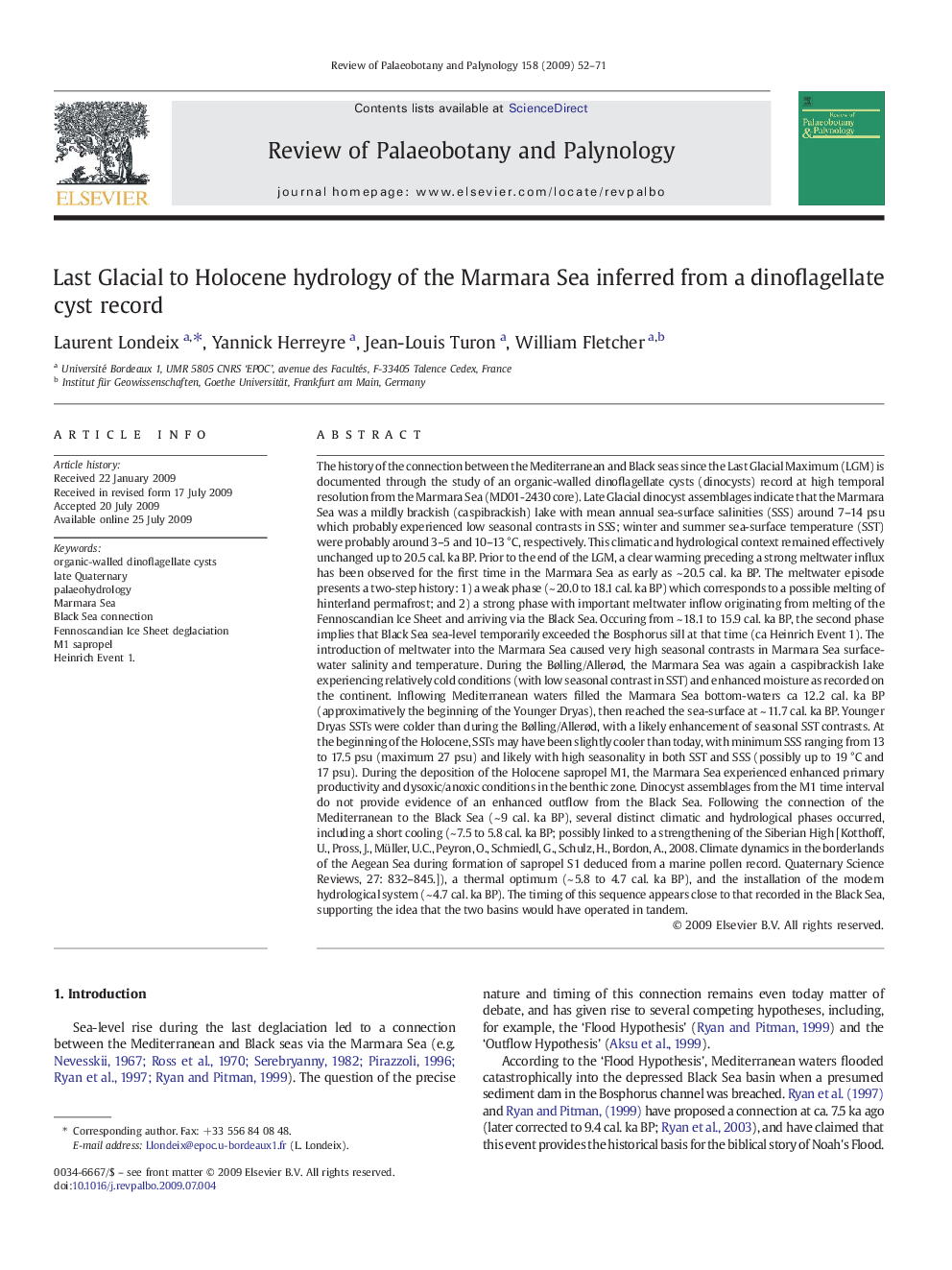| Article ID | Journal | Published Year | Pages | File Type |
|---|---|---|---|---|
| 4750751 | Review of Palaeobotany and Palynology | 2009 | 20 Pages |
Abstract
The history of the connection between the Mediterranean and Black seas since the Last Glacial Maximum (LGM) is documented through the study of an organic-walled dinoflagellate cysts (dinocysts) record at high temporal resolution from the Marmara Sea (MD01-2430 core). Late Glacial dinocyst assemblages indicate that the Marmara Sea was a mildly brackish (caspibrackish) lake with mean annual sea-surface salinities (SSS) around 7-14 psu which probably experienced low seasonal contrasts in SSS; winter and summer sea-surface temperature (SST) were probably around 3-5 and 10-13 °C, respectively. This climatic and hydrological context remained effectively unchanged up to 20.5 cal. ka BP. Prior to the end of the LGM, a clear warming preceding a strong meltwater influx has been observed for the first time in the Marmara Sea as early as ~ 20.5 cal. ka BP. The meltwater episode presents a two-step history: 1) a weak phase (~ 20.0 to 18.1 cal. ka BP) which corresponds to a possible melting of hinterland permafrost; and 2) a strong phase with important meltwater inflow originating from melting of the Fennoscandian Ice Sheet and arriving via the Black Sea. Occuring from ~ 18.1 to 15.9 cal. ka BP, the second phase implies that Black Sea sea-level temporarily exceeded the Bosphorus sill at that time (ca Heinrich Event 1). The introduction of meltwater into the Marmara Sea caused very high seasonal contrasts in Marmara Sea surface-water salinity and temperature. During the Bølling/Allerød, the Marmara Sea was again a caspibrackish lake experiencing relatively cold conditions (with low seasonal contrast in SST) and enhanced moisture as recorded on the continent. Inflowing Mediterranean waters filled the Marmara Sea bottom-waters ca 12.2 cal. ka BP (approximatively the beginning of the Younger Dryas), then reached the sea-surface at ~ 11.7 cal. ka BP. Younger Dryas SSTs were colder than during the Bølling/Allerød, with a likely enhancement of seasonal SST contrasts. At the beginning of the Holocene, SSTs may have been slightly cooler than today, with minimum SSS ranging from 13 to 17.5 psu (maximum 27 psu) and likely with high seasonality in both SST and SSS (possibly up to 19 °C and 17 psu). During the deposition of the Holocene sapropel M1, the Marmara Sea experienced enhanced primary productivity and dysoxic/anoxic conditions in the benthic zone. Dinocyst assemblages from the M1 time interval do not provide evidence of an enhanced outflow from the Black Sea. Following the connection of the Mediterranean to the Black Sea (~ 9 cal. ka BP), several distinct climatic and hydrological phases occurred, including a short cooling (~ 7.5 to 5.8 cal. ka BP; possibly linked to a strengthening of the Siberian High [Kotthoff, U., Pross, J., Müller, U.C., Peyron, O., Schmiedl, G., Schulz, H., Bordon, A., 2008. Climate dynamics in the borderlands of the Aegean Sea during formation of sapropel S1 deduced from a marine pollen record. Quaternary Science Reviews, 27: 832-845.]), a thermal optimum (~ 5.8 to 4.7 cal. ka BP), and the installation of the modern hydrological system (~ 4.7 cal. ka BP). The timing of this sequence appears close to that recorded in the Black Sea, supporting the idea that the two basins would have operated in tandem.
Related Topics
Physical Sciences and Engineering
Earth and Planetary Sciences
Palaeontology
Authors
Laurent Londeix, Yannick Herreyre, Jean-Louis Turon, William Fletcher,
